The Egyptian Pyramids
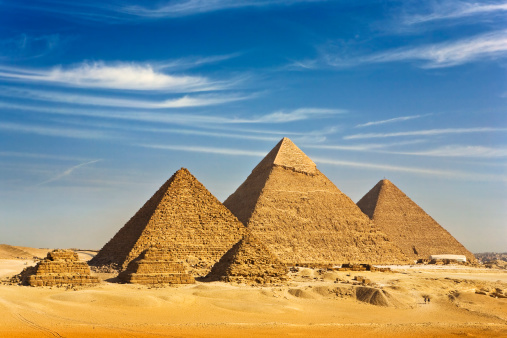
In the land of Egypt, there are many pyramids that dot the land. More than a hundred have been discovered, and they date to being thousands of years old.
The Egyptians built these pyramids as tombs for their royalty, but what is the deeper history to all of it? In truth, the pyramids are the potential descendants of an even further point of the past of human history AND are the sign of an evolution in human architecture more visible than anything before it.
What Inspired The Pyramids?

There are quite a few structures that predate the pyramids of Egypt, but they seem to be for similar purposes. In nearby Mesopotamia, there are the ziggurats and they are believed to be the most direct inspiration on the pyramids.
The ziggurats were built by the Sumerians. The Sumerians believed that at the top of the ziggurat was where the gods of the ziggurat resided, and thus only the priests were allowed to enter the top of them.
The culture of ziggurats was preserved by the Akkadians as well. The Akkadians added a bit more of a temple type structure onto the bodies of each of the ziggurats.
Babylon would later take the building techniques of the Sumerians and Akkadians and make much more elaborate things than their predecessors. They would also use much more color in their constructing.
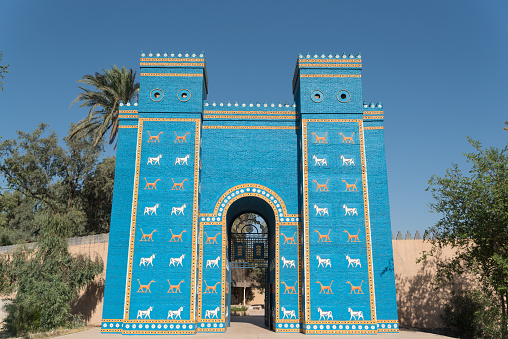
The construction of these Sumerian ziggurats spanned from around 4,000 BC until closer to 3,000 BC. At the time, Egypt was split into different kingdoms but was gradually beginning to come together along with the rise of the iconic elements of Egyptian culture that are remembered today.
There are also megalithic structures all over the cultures bordering the Sahara. These megaliths come from late Neolithic cultures ranging around 5,000 BC to 4,000 BC. They may have also been inspirations that the Egyptians were aware of before they began constructing their pyramids, or perhaps they were inspirations to the obelisk which was another prominent piece of architecture from Ancient Egypt.
The First Pyramid

In the Old Kingdom, which began around 2700 BC, Egypt was under the rule of the 3rd Dynasty. Previously, tombs called mastabas had been used to bury the kings.
However, a pharaoh named Djoser and his vizier named Imhotep had bigger ideas than a simple mastaba like every other king before Djoser. In 2670 BC, construction began to create the Great Step Pyramid.
Imhotep designed the pyramid based on the idea of stacking mastaba structures on top of each other like a staircase. Imhotep was an incredibly good architect, he switched out using mud bricks for using limestone.
In addition to being a good architect, Imhotep was believed to be a demigod and had the power of healing. He was in the direct service of Ra as Ra’s high priest.
Imhotep, in death, was one of the very few Egyptians to be deified that was not royalty. Cults for him were found in the Egyptian city of Memphis.
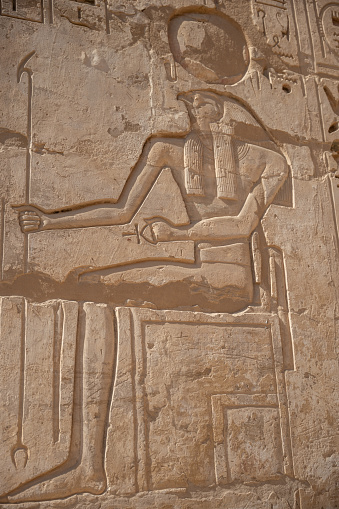
The Road To True Pyramids
Djoser’s pyramid was an incredible achievement for the ancient architectural world, but it is not really like the pyramids that we usually think of today. So how did Egypt get from the Great Step Pyramid to the ‘true’ pyramids?
The descendants of Djoser continued to build pyramids in his fashion by stacking mastabas. But when the 4th Dynasty began with Pharaoh Sneferu, an evolution began in pyramid construction.
Sneferu had the desire to make his pyramid smoother and more triangular, but the angles to do this were not quite understood yet. At Meidum, he attempted to build a Step Pyramid that would be smooth at the bottom and turn into a more triangular top.
Unfortunately for Sneferu, this was not a suitable structure to stay standing. It partially collapsed, though because of the usage of limestone you can still go to Meidum and see the remains.
Sneferu still needed something to be buried in, so Sneferu began work on his second attempt at a true pyramid. The construction began at Dahshur at some point between 2600 BC and 2500 BC.
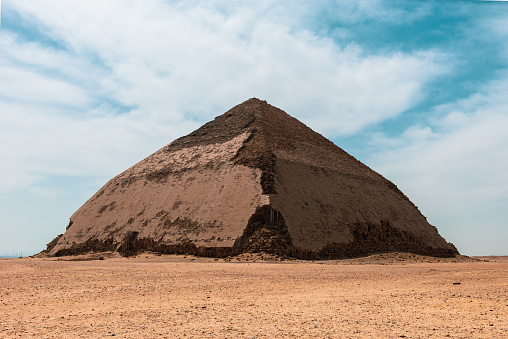
As you can see in the picture above, it didn’t work out. Sneferu used much better angles than before, but as they were making progress they began to notice instability and had to change the angles.
The changing of the angles furthered the instability of the pyramid rather than fix it, and this resulted in the top of the pyramid taking on a bent appearance. Sneferu, out of embarrassment, refused to be buried in that pyramid and thus went on to attempt to build a third pyramid before he died.
The First True Pyramid
Sneferu’s final pyramid was built with angles similar to the Bent Pyramid’s angles but a bit more precisely to the perfect angles. This managed to allow the pyramid to retain stability and because it was made of limestone it still stands today.
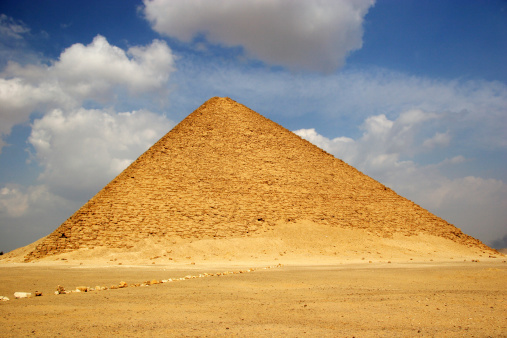
Sneferu’s final pyramid is called the Red Pyramid because it takes on a bit of a red color due to the red brick used in the construction of it. This is the pyramid that Sneferu is buried in and it is the third largest Egyptian pyramid that we have ever discovered.
Sneferu was an incredibly powerful pharaoh and it makes sense why he wanted such an impressive structure to be built in. Sneferu launched successful conquests to invade Libya and Nubia, and returned with many riches for Egypt.
Sneferu also greatly expanded Egypt’s large scale quarries, including turquoise mines in the Sinai Peninsula. Most likely, the original start of this came because of the need of stone for the pyramids he built.
Sneferu also has an ancient cedar wooden ship named the Praise of the Two Lands, which is the first known instance of a ship being referred to by a name.
The Great Pyramid

After Sneferu, the next pharaoh was his heir: Khufu. Khufu was named after the god Khnum.
Khnum is one of the earliest known deities in the Egyptian religion and he is the god who is the source of the Nile River. Khnum brings water and life and also invented pottery.
Khnum is also called the father of Ra in some sources, with Neith as his lover. Khnum has many sacred sites in Egypt and is also a guardian to the Egyptians and their land.

Khufu being named after Khnum did a lot of work to increase the popularity and spread of Khnum to others. Khufu also shows a trend of Egyptian royalty to associate themselves, by their own name, with a deity and get the blessings of that deity.
Khufu is the heir of Sneferu, but it is unknown if he is actually Sneferu’s son or just a selected descendant. The general belief from the public is that he is, in fact, Sneferu’s own son.
In fact, Sneferu’s wife was found in a tomb just east of Khufu’s pyramid. This supports the claim that she was Khufu’s mother and that Sneferu was Khufu’s father.
So, Khufu’s Pyramid. Khufu’s Pyramid is known as the Great Pyramid of Giza. The Great Pyramid of Giza is the only pyramid at Giza that is the “Great Pyramid” the other two are not actually called that they are just called part of the Pyramids of Giza.
Khufu’s Pyramid is the largest Egyptian pyramid ever built, and it stood at 481 feet tall (or 147 meters). The angles were perfected past Sneferu’s experimentation.
Khufu had to move north to Giza and away from Dahshur because the limestone quarries were drained. Khufu went to the high end of Giza’s plateau for best visibility of his monument.
Khufu’s pyramid also includes a king’s chamber and an unfinished queen’s chamber. Why it went unfinished remains a mystery.
Khafre’s Pyramid

This pyramid pictured above is Khafre’s pyramid. It is usually mistaken for the Great Pyramid of Giza, but it is not.
This pyramid is also not taller than the Great Pyramid, it merely stands at a higher elevation which makes it look like a taller structure. The Great Pyramid is the tallest Egyptian pyramid, this one is the second tallest Egyptian pyramid, and Sneferu’s Red Pyramid was the third largest Egyptian pyramid.
Khafre lived in the 2500s BC, and his pyramid was built around that time as well. Khafre was the third Pharaoh of the 4th Dynasty after his father, Khufu, and his possible grandfather Sneferu.
Khafre was not the original heir to take over after Khufu, the original heir was his older brother but he died before Khufu did. So instead of him, Khafre was the next one to be crowned Pharaoh of Egypt.
Whereas Khafre’s father was devoted to Khnum, Khafre was devoted to Horus. Horus is the god of kings and of the sky in the Egyptian pantheon.
Khafre’s siblings all got minor pyramids near the pyramids of he and his father.
Menkaure’s Pyramid

Menkaure was the next Pharaoh after Khafre and was the son of Khafre and ruled sometime close to 2500 BC and reigned for around 22 years. Menkaure was said to be an easier ruler on his people than those who came before him, but we do not really know that much about him or his reign other than supply documentations.
Menkaure’s pyramid is smaller than the other two pyramids of Giza and is the last pyramid to be made out of limestone. It also sits out of line with the other two pyramids because the true alignment of the pyramids is not with each other but rather with the stars in the belt of Orion.
Pyramids After Menkaure
After Menkaure and the 4th dynasty, there are more pyramids that are made but they are typically made using mud brick and not limestone. Due to this change in material, those pyramids have mostly eroded away and we have simply uncovered the remains of where and what they once were.
These mud pyramids came from the Middle Kingdom period. This means they were built sometime between 2055 BC and 1650 BC.
The Middle Kingdom also saw the push into the lands of Nubia by the Egyptians, which would later cause the people living in Nubia (also known as Kush or Sudan) to construct their own pyramids.

A fun fact, there are actually more pyramids in Sudan than there are in Egypt but none of the pyramids in Sudan are as big or architecturally revolutionary. They also were for people who were much less prominent as leaders/rulers than the pharaohs of Ancient Egypt were.
Buildings Inspired By The Pyramids

In the United States of America, there is a pyramid in Memphis, Tennessee made out of glass. The pyramid in Memphis was originally the city’s coliseum but later it was bought by Bass Pro Shop.
So, today, there is a gigantic Bass Pro Shop Pyramid next to the Mississippi River. It also has a hotel on the top floors.
In Nevada, there is the Luxor Hotel & Casino which is shaped like a pyramid and is black in color but this is odd because Luxor is a place in Egypt that does not have any pyramids and is instead famous for New Kingdom temples.
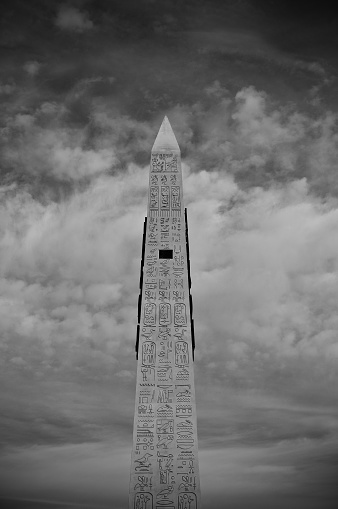
There are also pyramids in Latin America that come from the Ancient Amerindian cultures.

Pictured above is the Pyramid of the Sun and its other neighboring Pyramid of the Moon and other related buildings. The Pyramid of the Sun was built by Amerindians living in the area of Mexico City and was most likely constructed around 2,000 years ago.
The Pyramid of the Sun served as both a place to be buried and as a place to worship in the upper levels. The Pyramid of the Sun is also very large, clocking in the ranks of size as the third largest Pyramid from the ancient world (Sneferu’s is the third largest EGYPTIAN pyramid, not third largest pyramid period).
Artifacts made from obsidian and artifacts related to snakes have also been found among the Pyramid of the Sun and many things that were inside it are now in the collection of the British Museum. If you go to the top of the Pyramid of the Sun, your view is obstructed by a very terribly placed Walmart.
The Pyramid of the Sun is not traditionally believed to be built by the same people who built the Egyptian Pyramids but hear me out. The Great Pyramid and the Pyramid of the Sun have the exact same angles and starting foundation dimensions.
This tells us that clearly their must be a deeper connection. If not directly then in the way we understand culture to develop and influence of religion.